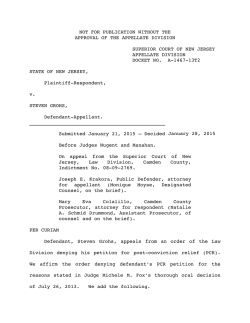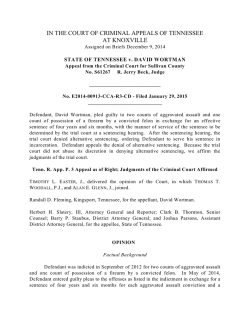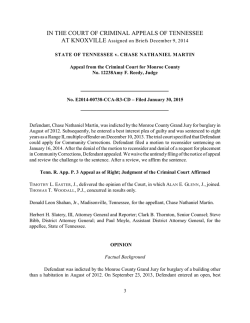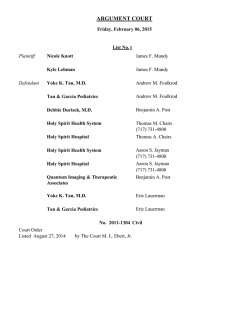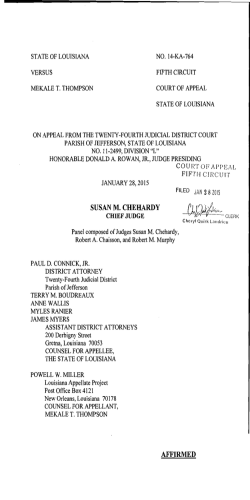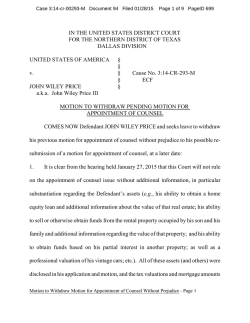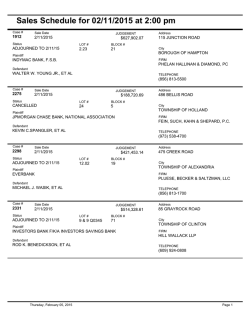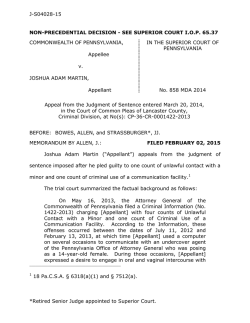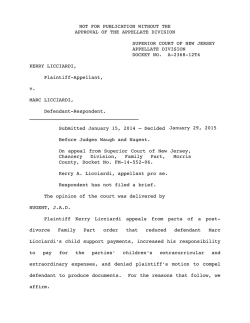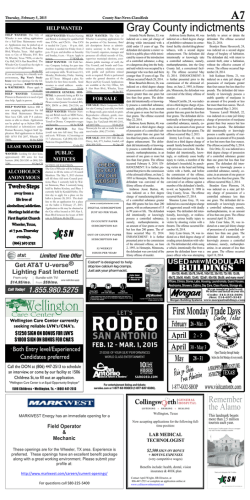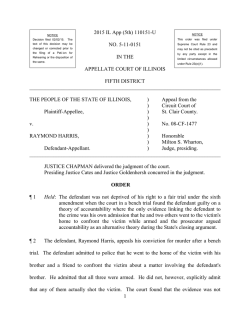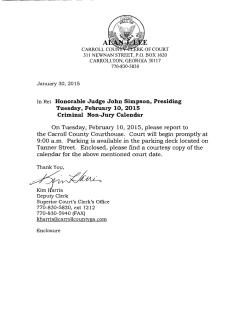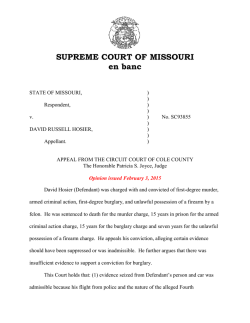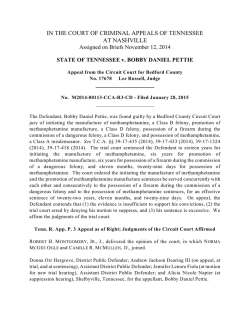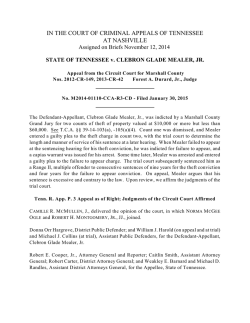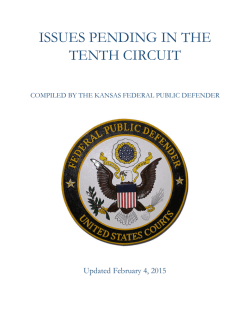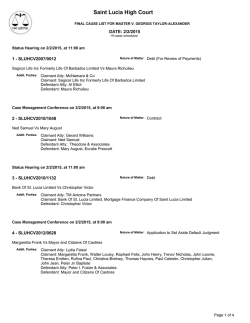
State of Tennessee v. Leon Booker
IN THE COURT OF CRIMINAL APPEALS OF TENNESSEE AT NASHVILLE Assigned on Briefs December 9, 2014 at Knoxville STATE OF TENNESSEE v. LEON BOOKER Appeal from the Circuit Court for Maury County Nos. 21108, 21198 Stella L. Hargrove, Judge No. M2014-00840-CCA-R3-CD - Filed January 30, 2015 The defendant, Leon Booker, pled guilty to theft over $500, a Class E felony, and theft under $500, a Class A misdemeanor, and was sentenced as a Range III offender to six years for the felony conviction and to eleven months and twenty-nine days for the misdemeanor conviction, to be served consecutively. On appeal, he argues that the trial court erred in sentencing him as a Range III offender. After review, we affirm the sentencing decision of the trial court. Tenn. R. App. P. 3 Appeal as of Right; Judgments of the Circuit Court Affirmed A LAN E. G LENN, J., delivered the opinion of the Court, in which T HOMAS T. W OODALL, P.J., and T IMOTHY L. E ASTER, J., joined. Ronald G. Freemon, Columbia, Tennessee, for the appellant, Leon Booker. Herbert H. Slatery, III, Attorney General and Reporter; Brent C. Cherry, Senior Counsel; Mike Bottoms, District Attorney General; and Brent A. Cooper, Assistant District Attorney General, for the appellee, State of Tennessee. OPINION FACTS In Case No. 21108, the defendant was indicted for theft of property valued at $500 or less as the result of his obtaining bush hogs belonging to Wayne Romesburg. In Case No. 21198, the defendant was indicted for theft of property valued at $1000 or more but less than $10,000, a Class D felony, based on his obtaining or exercising control over eight tractor trailer tires belonging to David Harris. Subsequently, the State filed a notice of intent to seek enhanced punishment as a Range III offender based upon the defendant’s prior convictions for four counts of aggravated burglary, two counts of burglary, three counts of theft of property, and one count of auto burglary. On December 17, 2013, the defendant entered guilty pleas in Case No. 21198 to Class E felony theft and in Case No. 21108 to Class A misdemeanor theft. At the March 28, 2014 sentencing hearing, the State introduced the defendant’s presentence report, which revealed a substantial criminal history, including “13 felonies and 15 misdemeanors.” Victim David Harris testified that he owned a farm and a trucking business and that he was acquainted with the defendant but “just knew . . . his name and his face, . . . that’s pretty much it.” In September 2011, Harris discovered that the lock to the gate on his property had been cut and some tires were missing. The tires had been in an open hay barn behind two gates. He described the tires: “They were for a semi. They’re – 245 is their size. They’re twenty-four-inch tubeless tires. . . . And they go on a tractor-trailer.” He called the sheriff’s department, and a report was filed. He also called his mechanic, R.P. Williams, and other trucking companies and asked them to “be on the lookout, because when stuff is stolen, people try to sell it.” He subsequently recovered four of the missing tires from Williams, after the defendant sold the tires to Williams for $340. Harris also recovered four more tires from Mike Gibson, the owner of a scrap metal and recycling business. Mike Gibson testified that he had dealt with the defendant for years at his scrapyard and recycling business. In September 2011, the defendant brought “two 1125 tires and one of the twenty-four-inch, the 1,124 inch tires” to his business, and Gibson purchased the tires for $625. Gibson said that the defendant’s mother had been making periodic payments to reimburse him for his $625 loss and that the amount had been paid in full. The defendant testified that he wrote letters of apology to Harris and Gibson and gave them to his mother, who hand-delivered them. He said that restitution to Harris and Gibson had been paid from his bank account. He acknowledged that drugs were “a contributing factor” in his committing the offenses. Asked if he could be a productive citizen going forward, the defendant responded, “I will to the best of my ability.” He said he previously had successfully completed probation and parole. On cross-examination, asked if he had been placed on probation on February 22, 2011, following his guilty pleas to criminal trespass, theft, and vandalism, the defendant responded, “Yeah, I think so.” He admitted that he was on probation when he committed the offenses in the present case and that he previously had been incarcerated for aggravated burglaries and thefts. At the conclusion of the hearing, the trial court determined: -2- The prior record of [the defendant] is terrible. He has been a long thief [sic] since 1977, sir. He has a record that expands some 37 years of criminal activity, resulting in 13 felonies and 15 misdemeanors, before these offenses. His criminal activity starts in 1977, and runs through September of 2011, so some 37 years. I say he’s been a long thief [sic], because the [p]etty [l]arceny is the only larceny charge occurred for his conviction is November 1977, his first felony. He also had a weapon’s charge combined with that. And so his 13 felonies included multiple aggravated burglaries, multiple burglaries, auto burglary, multiple thefts and marijuana. His misdemeanors include weapon’s charge, theft, attempted forgery, assault, joyriding, vandalism, driving on revoke[d] [license], violations of orders of protection, criminal trespass. And it looks to the Court that he was clearly on bail on two offenses. They are misdemeanors, but they are violation of the law. . . . He was out on probation, also, when these offenses occurred. Additionally, the trial court found that the defendant had “at least four probation revocations.” The court then sentenced the defendant to six years, the maximum Range III sentence for a defendant convicted of a Class E felony, and to a consecutive term of eleven months, twenty-nine days for the misdemeanor conviction. ANALYSIS The defendant argues that the trial court erred in sentencing him as a Range III offender without requiring the State to present certified copies of his prior felony convictions. Under the 2005 amendments to the sentencing act, a trial court is to consider the following when determining a defendant’s sentence and the appropriate combination of sentencing alternatives: (1) The evidence, if any, received at the trial and the sentencing hearing; (2) The presentence report; -3- (3) The principles of sentencing and arguments as to sentencing alternatives; (4) The nature and characteristics of the criminal conduct involved; (5) Evidence and information offered by the parties on the mitigating and enhancement factors set out in §§ 40-35-113 and 40-35-114; (6) Any statistical information provided by the administrative office of the courts as to sentencing practices for similar offenses in Tennessee; and (7) Any statement the defendant wishes to make in the defendant’s own behalf about sentencing. Tenn. Code Ann. § 40-35-210(b) (2010). The trial court is granted broad discretion to impose a sentence anywhere within the applicable range, regardless of the presence or absence of enhancement or mitigating factors, and “sentences should be upheld so long as the statutory purposes and principles, along with any applicable enhancement and mitigating factors, have been properly addressed.” State v. Bise, 380 S.W.3d 682, 706 (Tenn. 2012). Accordingly, we review a trial court’s sentencing determinations under an abuse of discretion standard, “granting a presumption of reasonableness to within-range sentencing decisions that reflect a proper application of the purposes and principles of our Sentencing Act.” Id. at 707. Tennessee Code Annotated section 40-35-107(a)(1) defines a persistent offender, in pertinent part, as an offender who has “[a]ny combination of five (5) or more prior felony convictions within the conviction class or higher or within the next two (2) lower felony classes, where applicable[.]” Pursuant to his plea agreement in Case No. 21198, the defendant pled guilty to theft of property over $500, a Class E felony, with the provision, “Range III 4-6 at 45%.” At the sentencing hearing, the following colloquy occurred between defense counsel and the defendant regarding his classification as a Range III offender: Q. And there was some discussion at the first part of the hearing about that prior record and how you’re – as part of your record you’re considered to be a Range III Offender? A. Yes, sir. Q. You understand what that means based on our meeting the other day? -4- A. Yes, sir, I do. Q. You understand that any sentence that’s imposed by this Court you’ll have to serve a minimum of 45 percent of that – A. Yes, I understand. Q. – before you’ll be eligible for release? Of course, the Court has discretion to order some type of split confinement. You and I discussed that? A. Yes, sir. Q. And is that what you’re asking the Court for today? A. I am, sir. The defendant argues that the proof was insufficient “to justify use of an enhanced sentencing range” in sentencing him as a Range III offender because the State “failed to submit certified proof of his prior convictions.” Tennessee Code Annotated section 40-35-209(b) provides in pertinent part that, at a sentencing hearing, “reliable hearsay . . . may be admitted if the opposing party is accorded a fair opportunity to rebut any hearsay evidence so admitted.” This court has consistently held that the presentence report is reliable hearsay. State v. Baker, 956 S.W.2d 8, 17 (Tenn. Crim. App. 1997) (information contained in a presentence report is reliable because it is based upon the presentence officer’s research of the records, contact with relevant agencies, and the gathering of information which is required to be included in a presentence report). Further, this court previously has rejected an argument similar to the defendant’s. See State v. James Alton Campbell a/k/a Jamie Campbell, No. M2006-01817-CCA-R3-CD, 2007 WL 3275491, at *6 (Tenn. Crim. App. Nov. 7, 2007), perm. app. denied (Tenn. Apr. 14, 2008) (concluding that certified copies of prior judgments are not required to support defendant’s offender classification and that the court may take judicial notice of information in a presentence report). We conclude, therefore, that the defendant is not entitled to relief on the basis of this issue. -5- CONCLUSION Based upon the foregoing authorities and reasoning, the judgments of the trial court are affirmed. _________________________________ ALAN E. GLENN, JUDGE -6-
© Copyright 2024
